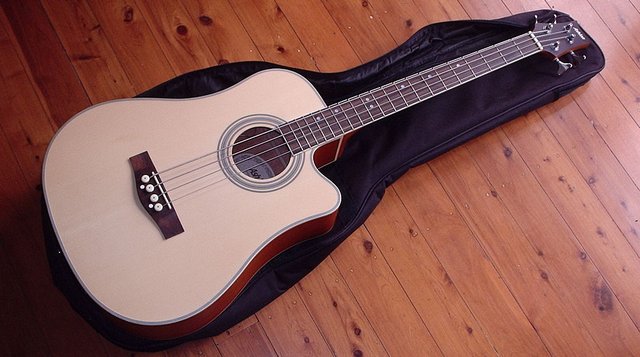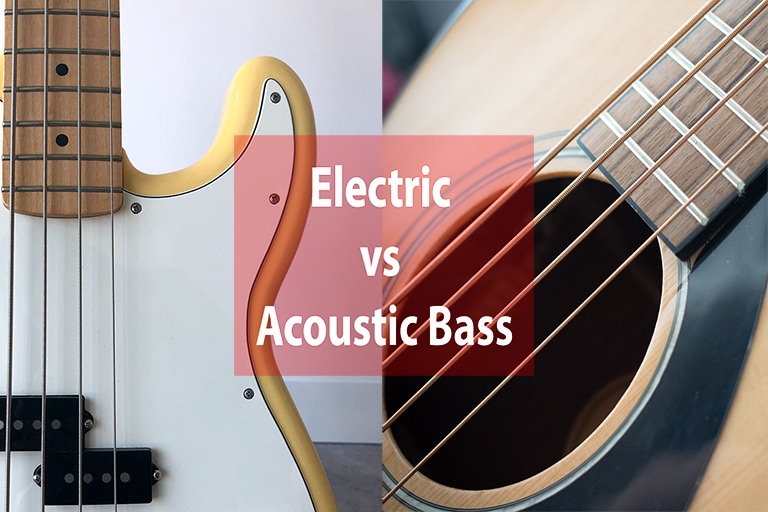Acoustic bass guitars look more like acoustic guitars rather than bass guitars. “Bass guitar” is actually short for an electric bass guitar which is a fully descriptive name. While most non–music–oriented people might have difficulty figuring out an electric guitar from a bass guitar, an acoustic bass is a very different instrument, even though both are intended to serve the same purpose.
Also check out our article on: Why Are Electric Guitars Easier to Play?
As a beginner trying to get started with bass guitars, you’d want to decide what you want to start your journey with early on. Is it the standard (electric) bass guitar or the acoustic bass?
Objectively, for a beginner, I would recommend the electric bass guitar. They have smaller bodies and are generally much more comfortable to hold and play than acoustic bass. One advantage of an acoustic bass over an electric one is not needing to plug it into an amp for practicing and intimate performances. They are not very loud, so you’ll need an amp to play in a band with other instruments.
Subjectively for you, the choice would depend on many factors, like the genre you’re most interested in playing, previous experience level, initial ease of playing you would like, etc. We’ll look at all these factors in detail in this article.
Let’s get started!
What is an Acoustic Bass Guitar?

These bass guitars have a hollow body similar to a standard acoustic guitar in that they have a sound chamber or soundbox which converts the strings’ vibration into a sound more effectively. But since these basses have a much smaller sound chamber than a double bass, they don’t produce as much sound on their own without external amplification.
The acoustic bass guitar usually has four strings with tuning E–A–D–G but an octave below the lowest four strings of a standard 6–string guitar. The strings and tuning are the same in electric and acoustic bass guitars.
Acoustic bass guitars are popular among genres such as jazz and country because of their warmer, richer tone than electric bass guitars.
Most acoustic guitars are, however, fitted with pickups for external amplification since they are hard to hear in a mix of instruments (even acoustic instruments). The sound chamber lends the acoustic bass a distinct resonant tone compared to the electric bass.
Acoustic bass guitars are not very popular except in Mexican music, where different variations of acoustic bass guitars are popular.
Acoustic Bass Guitar Characteristics
First and foremost, acoustic bass does not rely on electronics to produce sound. Much like acoustic guitars, they produce and “amplify” the sound with the help of the sound chamber (the hollow part of the guitar with a round hole). Though, they are rarely used acoustically as they cannot cut through the mix in band settings and need external amplification.
The strings in most acoustic bass are made of steel and are much thicker than electric bass because they need more vibrational energy to produce sound. Heavier gauge strings mean you need to apply more finger pressure to fret a string and to strum.
These guitars are also bigger than standard acoustic guitars since amplifying bass frequencies need a bigger sound chamber, which is why the upright or double bass is so big. The difference contrasts with electric bass, which has relatively thinner strings and a smaller body, though still bigger than standard electric guitars.
Many acoustic bass guitars come fitted with an electronic pickup system. These guitars can be connected to bass amps much the same as electric bass and produce a distinct tone loved by certain musicians.
What is an Electric Bass Guitar?

Electric bass guitars have a solid wooden body, much like standard electric guitars but have a longer scale length. Similar to acoustic bass, these guitars have four strings in the same E–A–D–G tuning, which, to reiterate, is an octave below standard guitars.
Other popular electric basses may have 5 or 6 strings and are called extended–range bass guitars. These are used by some bassists or for certain song performances. Electric basses rely solely on the electronic system to produce sound and are more suitable for live performances.
Electric basses have an onboard EQ system that lets you fine–tune the tonal output much better. The EQ and separate volume control for each pickup provide finer control over the tone that most acoustic bass lack. The preamp on active basses that require batteries provides even more control over the tone right from the bass itself.
Most people love the versatility the electric bass offers, and it is, therefore, the bass instrument of choice for a majority of musicians.
Electric Bass Guitar Characteristics
Electric bass guitars use electronics for sound amplification, which consists of a pickup, a preamp, and EQ. Compared to acoustic bass, the sound of these guitars is not very audible when played without an amp.
The pickup that transforms the strings’ vibrations into electric signals is located beneath the strings. The resulting signals are sent to the onboard electronics system consisting of the preamp and EQ. This allows the bassists to modify the timbres or tonal output before being sent to the amplifier.
Because sound production relies on electronics, the strings are relatively thinner than acoustic bass, making them easier to play for beginners.
Similarities Between Acoustic and Electric Bass Guitars
Both these guitars are the lowest–pitched instrument in the guitar family and are essentially the successors of an upright bass. Since they are both built for, essentially, the same purpose, which is to be a part of the bassline, there will be similarities between electric and acoustic bass.
Let’s look at them below.
Strings and Tuning Are the Same
In their standard form, both types of bass guitars have four strings tuned to E–A–D–G, similar to the lower four strings of standard (non–bass) guitars but are an octave below.
Generally, bass guitars are played with fingers rather than a pick. The string vibration is “amplified” (or converted to sound waves) through the sound chamber or soundbox in acoustic bass. At the same time, the electronic system is responsible for sound production in electric bass.
Costlier than Standard Guitars
Though electric bass guitars are more expensive than acoustic ones, they are both usually priced higher than their (non–bass) counterparts. For example, a decent acoustic bass would easily be priced at least $100–$150 more than a similarly decent acoustic guitar.
Longer Neck and Scale Length
Both these guitars have a longer neck and, subsequently, a longer scale length. Both guitars also have tuning pegs for tuning and are fretted instruments, though fretless varieties also exist for both electric and acoustic bass.
An Amp is Almost Always Needed

An acoustic bass, unlike an acoustic guitar, is not typically something that you can take for, say, camping and play songs on for your friends. So, even though they are acoustic, they are not meant to be played acoustically much.
You can practice an acoustic bass unplugged, but for any gigging, including acoustic–only gigs, you would need external amplification to cut through the mix. There is a reason why the upright bass is huge — bass frequencies need a lot of vibrational energy and a large sound chamber to move enough air to be heard acoustically.
Differences Between Acoustic and Electric Bass Guitars
Despite the similarities, acoustic and bass guitars are very different instruments. They’re not interchangeable, so if someone plays one, they may or may not like playing the other. Everything from the size, “feel,” and the sound produced is different. Let’s have a look at the differences in detail:
Need for an Amp
Electric bass guitars need additional devices like amplifiers, which need electricity to work. On the other hand, acoustic bass doesn’t need anything, and you can practice and even play without an amp. Although in a band setting, you might need an amp for the acoustic bass to be heard.
Sound Output
The volume of acoustic guitars is pretty much fixed — you cannot make it louder. Strumming too hard for that extra bit of sound may damage the strings as well as the guitar. Electric bass relies on external amplification and can go as loud as the amp’s power output allows. Many acoustic basses do have the option to have it plugged into an amp so that the volume can be at a hearing level in large performances.
In addition, the tone is also very different in electric and acoustic bass. Not only that, but electric basses have a better EQ that allows a player to fine–tune the tonal output.
Beginner Friendliness
The electric bass is easier to learn for beginners as the strings are less thick, and the action (distance of the strings above the fretboard) is lower compared to acoustic bass. Less thick strings mean less pressure to fret and strum the strings, and lower action means ease of fretting and changing between notes (and chords).
Also, for most people, the size of the acoustic bass makes them harder to play and is generally much more uncomfortable.
Size
Acoustic bass guitars are large instruments, larger than acoustic guitars. Electric basses are also bigger than their non–bass counterparts but not as bulky as acoustic bass. Playing an acoustic bass for someone of small or medium stature could be hard, especially standing up.
Versatility
Acoustic bass can be considered a “niche” instrument popular among some musicians in certain genres like jazz and country. Electric basses, however, are very versatile instruments popular among musicians and genres far and wide. The EQ and effects allow the bassist to shape the tone output, making the same guitar produce a distinct sound suitable for each song performance.
Also, advanced techniques like slapping and tapping are easier to perform with electric bass. These techniques are popular and employed a lot in modern music.
Price
Generally, you’ll find that electric bass is more expensive than acoustic bass because there are many more components in electric bass. However, this was not always the case as in the past owing to the low demand for acoustic bass; it was very hard to find something decent or good at a lower price.
Still, for the most part, electric bass guitars are generally more expensive.
Electric vs Acoustic Bass Guitar: Other Points to Consider
Convenience
Contrary to what some people think, acoustic basses are bulky and just plain uncomfortable to hold and play for most beginners. So, if you feel not needing an amp is a convenience, this pretty much negates it. Also, you’ll need an amp for playing anything in a band. Acoustic bass guitars are not nearly as loud as acoustic guitars. You can just about play it unplugged solo and with other acoustic guitar players (provided they play softly). Most other instruments like a keyboard and particularly a drum would totally make the acoustic bass inaudible.
Better Feedback
The one thing that is not talked about more is that while an acoustic guitar can feel uncomfortable to play, they are incredibly good at giving you feedback. You can hear even the most minor wrong techniques when playing acoustic bass, whereas, with an electric, most smaller mistakes go unnoticed. Noticing your mistakes can help improve your techniques, aiding you in learning bass guitar more effectively.
Don’t Need an Amp
Some of you might have noticed that “need for an amp” is both a similarity and a difference. Unlike an acoustic guitar, the acoustic bass falls somewhere between an acoustic and an electric instrument. While it can be played acoustically, you need an amp for most gig-level performances.
One advantage of an acoustic bass is that you do not need an amp, especially for practicing. In the perfect world, we would always have an amp handy to play our bass. But when we get the urge to play around with the bass for a minute here and there, it is tough to get a sound out of an electric bass when unplugged unless you bash it hard. It is an absolute convenience just to pick up the acoustic bass and be able to play without having to worry about amps and cables and power supply.
Fragility
Electric bass can take a few bumps and not suffer any damage due to the solid wood body. Acoustic bass, on the other hand, may suffer more damage. Also, an electric bass would still sound the same with a little chip here and there but not acoustic. You’ll have to take special care not to damage it while playing or transporting.
Demand
Owing to the popularity and versatility of electric bass, you can get in a band much more easily as an electric bassist. Not many bands are looking for acoustic bass players.
Prior Experience
Having experience with an acoustic guitar would help with an acoustic bass as the “feel” of both instruments are similar. If you like the sound and tone of acoustic guitars, having prior experience would negate a lot of the cons of acoustic bass and, therefore, may make it a more straightforward choice.
Final Thoughts
Acoustic bass guitars are suitable and popular among specific genres and generally not as popular as electric bass. Popularity, however, should not be the sole criteria for your decision. I feel we have discussed and highlighted many important points for you to make a sound decision (excuse the pun!).
For complete beginners, my recommendation would surely be to start with electric bass. After having some experience and better real–world knowledge, it would be easier to switch on to acoustic bass if that’s where you find your inclination lies.
In any case, have fun playing, and good luck with your music journey!
Photo credits:
- Bass Guitar by Andrewa, CC BY-SA 3.0, via Wikimedia Commons


